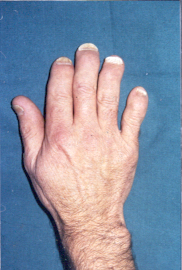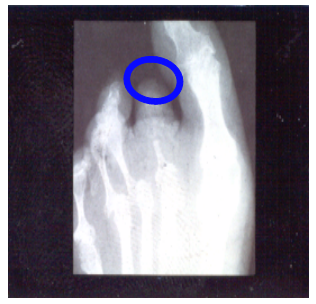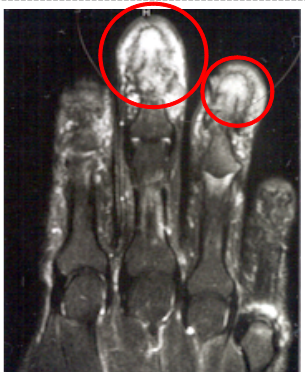Nail Disease and Arthritis Mutilans
Introduction
Psoriatic Arthritis was first described in Leeds in 1956 by the late Professor Verna Wright.
In the 1970s, with Dr John Moll, Wright classified Psoriatic Arthritis into 5 groups. These were:
- Asymmetric oligoarthritis
- Symmetric polyarthritis
- Psoriatic spondylitis with sacroiliac and spinal involvement
- Distal interphalangeal joint (DIP) arthritis
- Arthritis Mutilans (see below)

|
Figure 1. Involvement of the joints adjacent to the nail termed the distal interphalangeal joint is a very characteristic feature of Psoriatic Arthritis. Historically this was an enigmatic observation that was hard to explain. |
Arthritis Mutilans
The fifth category of Psoriatic Arthritis described by Moll and Wright was termed Arthritis Mutilans.

|
| Figure 2. This is an X-Ray of a Psoriatic Arthritis patient showing severe bone destruction termed Arthritis Mutilans. The bone underneath the nail has been completely dissolved. This type of arthritis is rare but highly destructive. The blue circle shows the region underneath the nail where the bone has completely disappeared. |
Until recently the link between Arthritis Mutilans and Nail disease was poorly understood.
Arthritis Mutilans Explained
As explained elsewhere in this site it is now known that the Arthritis Mutilans is related to the fact that the nail is anchored directly to the bone which contributes to this pattern of pathology.
Enthesitis is associated with bone inflammation or what is termed osteitis.
The tendons and ligaments around the Distal Interphalangeal Joint are closely linked into the nail [1] [2].
Therefore the nail, the joint and the underlying bone are a functional unit.
The bone inflammation may lead to the activation of specialised cells termed osteoclasts.
These cells make acid which dissolves the underlying bone which leads to the X-ray appearance in Figure 2.
 |
| Figure 3. This is a Magnetic Resonance Imaging scan of the hand in a patient with early stage Arthritis Mutilans. The areas inside the red circles show extensive bone inflammation which is called osteitis. This likely drives cells called osteoclasts to lead to joint destruction. |
Treatment for Arthritis Mutilans
Rapid bone loss and functional impairment can occur in Arthritis Mutilans.
Fortunately Arthritis Mutilans is fairly rare.
It may have become less common in the past few decades due to more vigorous therapy with conventional DMARD drugs.
The anti-TNF drugs give impressive clearance of nail disease.
The anti-TNF drugs are associated with resolution of bone marrow inflammation.
Although not proven beyond doubt it is likely that these agents are effective in this type of arthritis.